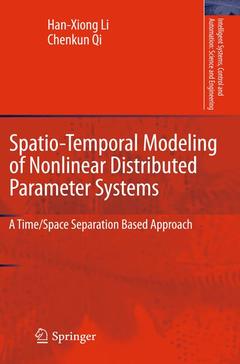Spatio-Temporal Modeling of Nonlinear Distributed Parameter Systems, 2011 A Time/Space Separation Based Approach Intelligent Systems, Control and Automation: Science and Engineering Series, Vol. 50
Auteurs : Li Han-Xiong, Qi Chenkun

The purpose of this volume is to provide a brief review of the previous work on model reduction and identifi cation of distributed parameter systems (DPS), and develop new spatio-temporal models and their relevant identifi cation approaches.
In this book, a systematic overview and classifi cation on the modeling of DPS is presented fi rst, which includes model reduction, parameter estimation and system identifi cation. Next, a class of block-oriented nonlinear systems in traditional lumped parameter systems (LPS) is extended to DPS, which results in the spatio-temporal Wiener and Hammerstein systems and their identifi cation methods. Then, the traditional Volterra model is extended to DPS, which results in the spatio-temporal Volterra model and its identification algorithm. All these methods are based on linear time/space separation. Sometimes, the nonlinear time/space separation can play a better role in modeling of very complex processes.
Thus, a nonlinear time/space separation based neural modeling is also presented for a class of DPS with more complicated dynamics. Finally, all these modeling approaches are successfully applied to industrial thermal processes, including a catalytic rod, a packed-bed reactor and a snap curing oven. The work is presented giving a unifi ed view from time/space separation. The book also illustrates applications to thermal processes in the electronics packaging and chemical industry. This volume assumes a basic knowledge about distributed parameter systems, system modeling and identifi cation. It is intended for researchers, graduate students and engineers interested in distributed parameter systems, nonlinear systems, and process modelingand control.
Preface;List of Figures;List of Tables;Abbreviations; 1 Introduction; 1.1 Background; 1.1.1 Examples of distributed parameter processes; 1.1.2 Motivation; 1.2 Contributions and organization of the book; 1.3 References; 2 Modeling of Distributed Parameter Systems: Overview and Classification; 2.1 Introduction; 2.2 White-box modeling: model reduction for known DPS; 2.2.1 Eigenfunction method; 2.2.2 Green’s function method; 2.2.3 Finite difference method; 2.2.4 Weighted residual method; 2.2.4.1 Classification based on weighting functions; 2.2.4.2 Classification based on basis functions; 2.2.5 Comparison studies of spectral and KL method; 2.3 Grey-box modeling: parameter estimation for partly known DPS; 2.3.1 FDM basedestimation; 2.3.2 FEM based estimation; 2.3.3 Spectral based estimation; 2.3.4 KL based estimation; 2.4 Black-box modeling: system identification for unknown DPS; 2.4.1 Green’s function based identification; 2.4.2 FDM based identification; 2.4.3 FEM based identification; 2.4.4 Spectral based identification; 2.4.5 KL based identification; 2.4.6 Comparison studies of neural spectral and neural KL method; 2.5 Concluding remarks; 2.6 References; 3 Spatio-Temporal Modeling for Wiener Distributed Parameter Systems; 3.1 Introduction; 3.2 Wiener distributed parameter system; 3.3 Spatio-temporal Wiener modeling methodology; 3.4 Karhunen-Loève decomposition; 3.5 Wiener model identification; 3.5.1 Modelparameterization; 3.5.2 Parameter estimation; 3.6 Simulation and experiment; 3.6.1 Catalytic rod; 3.6.2 Snap curing oven; 3.7 Summary; 3.8 References; 4 Spatio-Temporal Modeling for Hammerstein Distributed Parameter Systems; 4.1 Introduction; 4.2 Hammerstein distributed parameter system; 4.3 Spatio-temporal Hammerstein modeling methodology; 4.4 Karhunen-Loève decomposition; 4.5 Hammerstein model identification; 4.5.1 Model parameterization; 4.5.2 Structure selection; 4.5.3 Parameter estimation; 4.6 Simulation and experiment; 4.6.1 Catalytic rod; 4.6.2 Snap curing oven; 4.7 Summary; 4.8 References; 5 Multi-Channel Spatio-Temporal Modeling for Hammerstein Distributed Parameter Systems; 5.1 Introduction; 5.2 Hammerstein distributedparameter system; 5.3 Basic identification approach; 5.3.1 Basis function expansion; 5.3.2 Temporal modeling problem; 5.3.3 Least-squares estimation; 5.3.4 Singular value decomposition; 5.4 Multi-channel identification approach; 5.4.1 Motivation; 5.4.2 Multi-channel identification; 5.4.3 Convergence analysis; 5.5 Simulation and experiment; 5.5.1 Packed-bed reactor; 5.5.2 Snap curing oven; 5.6 Summary; 5.7 References; 6 Spatio-Temporal Volterra Modeling for a Class of Nonlinear DPS; 6.1 Introduction; 6.2 Spatio-temporal Volterra model; 6.3 Spatio-temporal modeling approach; 6.3.1 Time/space separation; 6.3.2 Temporal modeling problem; 6.3.3 Parameter estimation; 6.4 State space realization; 6.5 Convergence analysis; 6.6 Simulation and experiment; 6.6.1 Catalytic rod; 6.6.2 Snap curing oven; 6.7 Summary; 6.8 References; 7 Nonlinear Dimension Reduction based Neural Modeling for Nonlinear Complex DPS; 7.1 Introduction; 7.2 Nonlinear PCA based spatio-temporal modeling framework; 7.2.1 Modeling methodology; 7.2.2 Principal component analysis; 7.2.3 Nonlinear PCA for projection and reconstruction; 7.2.4 Dynamic modeling; 7.3 Nonlinear PCA based spatio-temporal modeling in neural system; 7.3.1 Neural network for nonlinear PCA; 7.3.2 Neural network for dynamic modeling; 7.4 Simulation and experiment; 7.4.1 Catalytic rod; 7.4.2 Snap curing oven; 7.5 Summary; 7.6 References; 8 Conclusions; 8.1 Conclusions; 8.2 References; Index.
Date de parution : 10-2014
Ouvrage de 175 p.
15.5x23.5 cm
Date de parution : 01-2011
Ouvrage de 175 p.
15.5x23.5 cm
